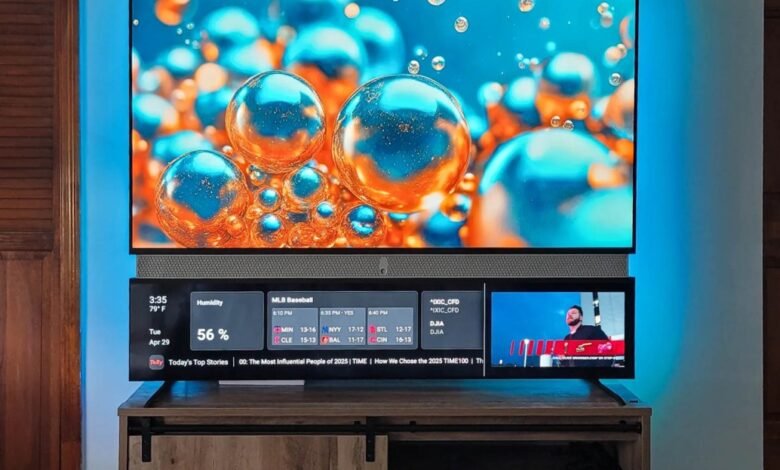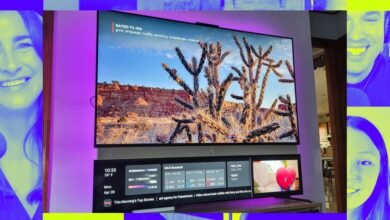I Tried the Free Ad-Supported Telly TV for 3 Months

▼ Summary
– Telly provides free TVs that feature a secondary screen constantly displaying ads and widgets, which cannot be turned off or dismissed during normal use.
– The TV collects extensive user data, including viewing habits and physical presence, and requires users to keep it connected and used as their main TV under strict terms of service.
– Telly’s software includes AI-generated news segments and preloaded apps, but accessing popular streaming services requires an additional Google TV dongle.
– The device includes built-in features like a camera with a privacy shutter, a microphone, and motion-tracking for fitness and games, though some components have performance issues.
– Despite offering decent picture quality and unique features, the persistent ads and software limitations lead to the conclusion that paying for a traditional TV may be preferable.
For the past three months, my living room has felt like a scene from a futuristic film, all thanks to a television I received at no cost. Each evening, as I settle in to relax, I pick up the remote and power on this 55-inch screen. Immediately, a smaller display beneath it flickers to life, crowded with widgets and a rotating advertisement that simply won’t disappear.
Before I can even select Netflix, a cheerful voice calls out, “Hello, hello friends!” A woman with neatly styled brown hair and a gray dress appears, this is the AI-generated likeness of actress Alison Fiori, hosting a built-in news segment that cycles through the day’s headlines. This setup represents the future of television according to Telly, the company behind this ad-supported model. In exchange for a free TV, users agree to a constant stream of promotions displayed on a secondary “smart” screen positioned just below the soundbar. This lower screen remains active at all times, during movies, shows, gaming, even when the main display is off, unless you press and hold the power button for several seconds.
Despite my best efforts to ignore it, the lower display consistently pulls my attention. Alongside the time, date, and weather, it streams headlines, stock updates, and links to news from sources like Fox News. You can customize which widgets appear, but the ad panel on the right is permanent. Telly’s terms explicitly forbid covering the screen, and since it’s also your navigation hub for apps and inputs, blocking it isn’t practical. You can dim the backlight, but setting it to zero barely makes a difference.
Some ads invite you to scan a QR code or press a remote button to view more on the main screen. Video ads run silently but include small subtitles that are tough to read from a distance. I’ve encountered promotions from Sunglasses Hut, Old Navy, and even local businesses like a crematorium and car dealerships. These appeared regardless of what I watched, whether it was 90 Day Fiancé, cooking shows, or crime dramas.
To qualify for a Telly, you must agree to use it as your primary home television, keep it connected to the internet, and watch it regularly. Violating these terms could mean returning the set or facing a $500 fee. I left mine unplugged for weeks while traveling and heard nothing from Telly, but the company’s chief strategy officer, Dallas Lawrence, emphasized they focus on long-term usage rather than short-term dips.
When my first unit arrived, the FedEx driver was both impressed and skeptical. After a quick phone search, he returned to my door warning that the TV might collect personal data, which, of course, is part of the arrangement. Unboxing revealed a completely cracked screen. Repackaging it was more frustrating than the wait for a replacement, though the return process itself was straightforward.
Once operational, I found the 4K HDR picture quality acceptable, though darker scenes sometimes looked grainy. The six-driver soundbar delivers strong audio, and customizable RGB backlighting adds a nice touch. Telly runs a customized Android system with limited preloaded apps like Spotify and Zoom; a Google TV dongle is included for accessing Netflix, Disney Plus, and other streaming services.
Every time you power on the TV, it defaults to the Telly home screen, where Alison Fiori’s AI avatar delivers the Telly Today news segment. This resets each time you leave the homepage, so you hear the same stories in the same sequence. Fiori covers celebrity updates, new trailers, and viral videos, like a dog teaching a piglet to use a doggy door. Telly cast her specifically for this role, blending her on-screen presence with advanced AI. A second host, resembling comedian Vinny Fasline, sometimes appears for trivia or internet highlights.
Between segments, ads play continuously. You can mute them with the remote’s “A” button, but the content isn’t always relevant, I once saw three Spanish-language ads in a row, despite not speaking the language.
The TV includes a built-in camera with a privacy shutter and a microphone. According to the terms, Telly may collect data on what you watch, for how long, and even detect who is in the room. This raised privacy concerns for me, making me uneasy about my viewing habits or conversations being monitored. The camera shutter only opens for compatible apps like Zoom. The video quality is comparable to a 2020 MacBook Air webcam, slightly grainy but usable. The microphone, however, produced a persistent buzz during my tests.
Zoom allows for watch parties, letting you view content on the main screen while video feeds appear below. It’s a clever feature, but switching between the dual displays felt clumsy. Exiting a call took several minutes of frantic button pressing. And yes, ads still show on the lower screen during meetings.
A preloaded fitness app called Gofa uses camera-based motion tracking, reminiscent of Xbox Kinect, along with casual games like Flappy Bird and Whack-a-Mole. Most games are fairly basic, but as a former Kinect enthusiast, I didn’t mind them.
The secondary screen also acts as a music controller for the Live One app, freeing up the main display. Sadly, Spotify takes over the entire screen once you start playing.
Telly’s ambitious approach to reimagining television is commendable. Getting a feature-packed TV, complete with a soundbar, RGB lighting, and camera, for free is undoubtedly appealing. Yet, the relentless advertising and occasional software issues drove home a clear realization: sometimes, it’s worth paying for a television.
(Source: The Verge)

